This section is intended to provide guidance on the prerequisites for the safe transportation of both track and wheel types of construction equipment on vehicles. The transportation of extremely large equipment on special purpose vehicles authorised by overweight and/or overdimension permits must be secured in accordance with the applicable sections of these guidelines, particularly in the Basic criteria and precautions section.
Basic criteria and precautions
Heavy construction equipment is normally transported on vehicles designed specifically for that purpose and provision is made to facilitate loading, unloading and securing of the load. Lighter machines may be transported on general-purpose vehicles provided the load restraint method is as secure as that of a specially constructed vehicle.
When vehicles are being driven onto a tilt bed, helpers should be cautioned to stand clear of the front of the tilt bed platform.
When a vehicle is carrying a load such as a wheeled or tracked vehicle, the load will be subject to forces that will tend to cause it to move. These forces will arise when a driver is braking, accelerating, cornering or moving over an undulating or rough surface.
In addition to the movement of the complete load there is a risk in some instances that part of the equipment (eg booms, superstructure) may have freedom of movement, and this can lead to dangerous situations arising when the vehicle is in motion and the load is subjected to the forces mentioned earlier.
If for some special reason a wheeled or tracked vehicle is positioned on the carrying trailer and not lashed down it would only be restrained from movement by its own skidding resistance if its brakes are applied.
Restraints must be provided. Even in normal driving situations the practice outlined above is inadequate. Additional restraints should take the form of a lashing system and some arrangement where the load is prevented from moving either forward or to the rear by an obstacle (or obstacles). These are securely fixed to the vehicle. They butt against the wheels or tracks or some other part of the equipment carried.
High loads risk contact with overbridges and overhead power lines. Since loads with a high centre of gravity will seriously affect the vehicle’s stability, such construction equipment should only be transported on vehicles with a low platform. Clearance heights along the route to be travelled should be checked against the loaded height of the transporter before travelling.
The following precautions should be taken when transporting construction equipment on a road vehicle.
All movable assemblies on the construction equipment such as jibs, buckets, booms, slewing superstructures and cabs, etc must be left in the position recommended for transportation by the manufacturer. They must be secured to prevent movement relative to the main body of the machine. Do not rely entirely on locking devices built into the machine.
The loaded machine should be inspected after the vehicle has been driven for a short distance to check that no movement has taken place and that restraining devices are still secure. Periodic inspections should be made during the course of the journey, preferably at intervals no longer than one hour.
The adjustable restraining system should be so arranged that failure or slackening of one component does not lead to failure or reduction in the effectiveness of the remainder. Restraints must not be passed round or fastened to items that may move relative to the base machine.
The brakes of the machine should be applied. In addition, the machine should be left in gear provided that it is impossible for the engine to be accidentally started in this condition. Bags, tool kits or heavy objects should not be left loose in the operator’s cab in case they knock the control levers, etc.
All twitches should be tied to prevent them releasing, causing a loss of tension in the chains, particularly when transporting rubber-tyred equipment.
Before loading, the loading platform should be cleared of all debris. The positioning of the construction equipment and any of its detached assemblies must be arranged so that the maximum vehicle and axle weights are not exceeded, and the safe handling of the vehicle is not impaired. The clearance between the undersides of low-loading vehicles and the road surface should be checked before moving off where there is a danger of ‘grounding’, eg on an uneven railway crossing. The ground clearance of any motor vehicle and any trailer attached is measured from the horizontal road surface to any point on the underside of the vehicle except the tyres, wheels and wheel hubs. It should not be less than 1/20th of the distance between adjacent axles under any loading conditions.
The machine should be positioned where possible on the carrying vehicle’s platform so that forward movement is prevented either by part of the main body of the vehicle (eg gooseneck step or headboard) or by an attached transverse member securely attached through the platform to the vehicle’s chassis frame.
All items such as buckets, grabs, blades, shovels and lifting appliances should be removed from the superstructure or chassis and secured to the deck of the vehicle.
Wheeled and light-tracked machines should be restrained so that the effect of bouncing caused by road shocks transmitted from the carrying vehicle and amplified by the machine’s tyres or suspension units is minimised. Where possible, the suspension unit of the machine should be locked and vertical movement limited by lashings or other means of restraint.
Where possible the full contact area of the equipment’s tyres, tracks or rolls should rest on the platform or extensions to the platform of the carrying vehicle.
All the wheels or rolls of the machine should be prevented from rolling or sliding relative to the deck of the vehicle.
The machine should be restrained against forward, backward or sideways movement by adjustable restraining devices attached to anchor points on the vehicle.
The overall height of the loaded vehicle should be checked before it is driven on the road. Although correctly stowed, the machine’s overall height may have changed since last transported through changing positions of its components, eg repositioning of pivot pin positions. It is also possible that a different vehicle will have a different platform height.
With the engine turned off, the pressure in a machine’s hydraulic system should be relieved by moving all control levers through all positions when the machine is stowed. This operation should be done at least twice. Exhaust stacks should be capped for turbo charger protection.
The principles to follow when deciding on the strength, number and position of anchor points to be fitted to a vehicle are described more fully in the Strength requirements of restraint systems section.
Strength requirements of restraint systems
The anchor points should be fixed securely to metal members of the chassis or cross members and should be capable of transmitting all the forces imposed on them to the main chassis of the vehicle.
Each anchor point should be capable of withstanding a force equal to the lashings being used, acting in any direction through which the lashing can be attached. In deciding the number of anchor points to be used when devising a restraint system, the following factors should be considered:
Unless loaded on a special purpose vehicle, there should never be less than four anchor points used, ie two per side.
The lashings or securing devices should only be attached to those parts of the engineering plant that are compatible in strength with the vehicle’s anchorage points. They should not be attached to any part of the machine being carried where there is a risk that damage can be caused when the vehicle is moving, eg a draw bar provides an ideal anchor point. When suitable anchor points are not readily available on a machine, it is recommended that special additional anchor points be provided (see the following illustrated examples). It is also recommended that, when purchasing new machines, suitable anchor points should be included before accepting delivery of the machine.
Apart from specialised fixing devices, the selection of material for use in tie-down schemes for construction equipment will be limited to chains, steel wire rope and the associated tensioning and coupling devices. Ensure the size is matched to the mass of the payload.
The strength of the lashing should be compatible with the strength of the anchor points used and its selection should be based on the restraint principles found in the Strength requirements of restraint systems.
Strength requirements of restraint systems
Where a transverse beam is used as a baulk, it should be securely fixed so that all loads imposed on it are transmitted to the carrying vehicle’s chassis. Where individual wheels or rolls are chocked with blocks or wedges these must be robust enough to resist crushing and be securely attached to the vehicle’s platform where possible.
Load pegs may be fitted along each side of the vehicle to prevent transverse movement, particularly on tracked vehicles (see following examples). The lashings or securing devices should only be attached to those parts of the construction equipment which are compatible in strength with the vehicle’s anchorage points. They should not be attached to any part of the machine where there is a risk that damage can be caused when the vehicle is in motion. It is important to ensure that lashings that provide front and back restraint are as near to the horizontal as possible and never more than 60° from the horizontal. This is because the stress in the lashing rises very sharply as the angle approaches the vertical and failure can occur. A chain that is placed at 60° to the horizontal provides a front or back restraining force equal to ½ the chain’s rated strength. If the chain is placed at 60° to the horizontal and 60° across the vehicle, its strength is reduced to ¼.
Recommended methods for restraining particular types of construction equipment and precautions to be taken are illustrated below. Variations of these methods are acceptable provided all the basic safety precautions outlined previously in the section have been applied.
On machines with articulated steering, articulation of the front part of the machine relative to the rear part should be prevented by fitting a locking device. You must relieve hydraulic pressure in the system by operating all controls twice with the engine off.
Hazard 1 – Height of the crane.
Precaution: Check the route. Ensure minimum clearance available exceeds maximum overall height of crane mounted on a low loader.
Hazard 2 – Movement of the boom and superstructure relative to the chassis of machine.
Precaution: Relieve the hydraulic pressure by operating the controls twice, with the engine off where possible. Engage slew lock if fitted, and if none fitted provide an independent restraint to prevent slewing motion.
Hazard 3 – Forward and rearward movement of the crane.
Precaution: Restrain with chains and tensioners at front and rear of the crane.
Hazard 4 – Sideways movement of the crane.
Precaution: Restrain with chains and tensioners on each side.
Note: Where cranes are to be transported considerable distances or over rough roads, it is recommended that the weight be removed off the tyres to prevent ‘bounce’ effects that are induced by road surface irregularities and large pneumatic tyres. Under severe conditions this bounce may snap restraining chains.
This can be achieved using the outriggers to lift the crane, taking the majority of the weight off the tyres. Large wooden blocks must then be packed between the low loader deck and outrigger beams. The outriggers must then be fully retracted in both vertical and horizontal positions. Chains and tensioners can then be applied to restrain the crane.
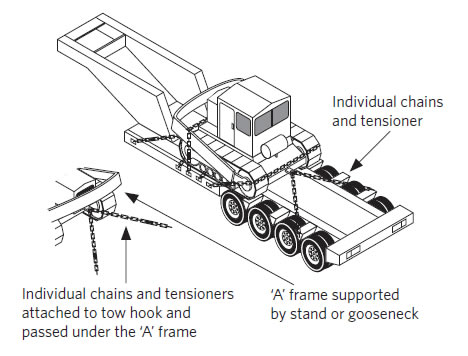
Figure 38 Suggested method of restraining a tractor dozer
Hazard 1 – Height of the machine.
Precaution: Check the route, determine the minimum clearance available. If necessary remove the canopy, exhaust pipe or any component exceeding the limit.
Hazard 2 – Width of the machine.
Precaution: Check the overall width of the machine is within the legal limits or conditions of an overdimension permit. ‘A’ frame and/or dozer blade may have to be removed. Depending upon axle loads and space available, these components may have to be transported separately.
Hazard 3 – Forward or rearward movement.
Precaution: Restrain with a pair of individual chains and tensioners at the front and rear of tractor dozer. Suggested anchor points on tractor dozer – drawbar at rear and tow hook in front.
Hazard 4 – Sideways movement of the machine.
Precaution: Restrain with a chain and tensioner on each side. Locate the chain behind carrier roller brackets. Desirable maximum length of chain is 4 metres.
Hazard 5 – Movement of items removed from the tractor dozer.
Precaution: Restrain dozer blade, ‘A’ frame, side arms, etc with independent individual lengths of chain no longer than absolutely necessary. Locate chains to provide as direct a tension as possible and to prevent movement forward, rearward or sideways.

Figure 39 Suggested method of restraining a hydraulic excavator (crawler mounted)
Hazard 1 – Height of the machine.
Precaution: Check route – ensure the minimum clearance available exceeds the maximum overall height of the excavator mounted on low loader.
Hazard 2 – Movement of the boom and superstructure relative to the chassis of machine.
Precaution: Relieve hydraulic pressure by operating all controls twice, with the engine off where possible. Engage slew lock if fitted, and if none fitted provide an independent restraint to prevent slewing motion.
Hazard 3 – Forward and rearward movement of the machine.
Precaution: Where load distribution permits, locate the rear of the excavator hard against gooseneck. Cradle the excavator in individual chains each tensioned with individual tensioners. Desirable maximum length of chains is 4 metres.
Hazard 4 – Sideways movement of the machine.
Precaution: ‘Cradle’ chains provide restraint in this direction, also.
Hazard 5 – Movement of buckets and attachments which are detached from the machine.
Precaution: Restrain with independent individual lengths of chain no longer than is necessary to prevent movement forwards, rearwards and sideways.
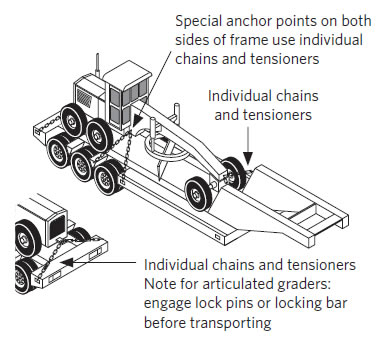
Figure 40 Suggested method of restraining a powergrader
Hazard 1 – Height of the grader.
Precaution: Check route, determine minimum clearance available. If necessary remove the canopy, exhaust pipe or any other component exceeding the limit.
Hazard 2 – Width of the grader.
Precaution: Angle the grader blade to reduce the overall width to within the legal limit, otherwise remove the blade.
Hazard 3 – Forward and rearward movement of the grader.
Precaution: Locate the front wheels or rear wheels against the gooseneck. Lower the blade onto the deck of the trailer. Restrain the grader at the front and rear. The drawbar and front axle bolster are ideal anchor points.
Hazard 4 – Sideways movement of the grader.
Precaution: Restrain with chains and tensioners on each side. Where necessary provide special anchor points on the grader frame to facilitate side restraint.
Hazard 5 – Movement of the blade that has been detached from the grader, on graders with articulated steering, articulation of front part of machine relative to rear part.
Precaution: Restrain with independent individual lengths of chain. Prevent movement forward, rearward and sideways. Fit locking device to prevent articulation. Relieve the hydraulic pressure in the system by operating all controls twice with the engine off where possible.
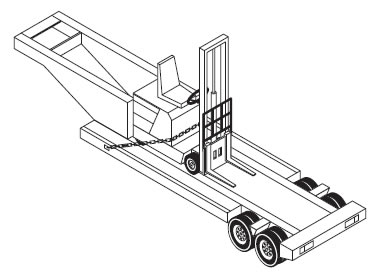
Figure 41 Suggested method of restraining a fork lift truck
Hazard 1 – Height of the fork lift.
Precaution: Check the route and determine the minimum clearance available. Ensure the minimum clearance exceeds the maximum overall height of the fork lift mounted on a low loader.
Hazard 2 – Forward and rearward movement of the fork lift.
Precaution: Where possible butt the rear of the fork lift (counterweight) hard against the gooseneck of the low loader. Restrain with a ‘cradle’ chain and tensioner. The desirable maximum length of chain is 4 metres. Lower the forks onto the deck of a low loader.
Hazard 3 – Sideways movement of the fork lift.
Precaution: A cradle chain provides restraint in this direction also.

Figure 42 Suggested method of restraining a pneumatic tyred 4-wheel drive loader
Hazard 1 – Height of the loader.
Precaution: Check the route. Determine the minimum clearance available. Ensure the minimum clearance exceeds the maximum overall height of the loader mounted on a low loader. Remove components exceeding the limit.
Hazard 2 – On loaders with articulated steering. The articulation of the front part of machine is relative to the rear part.
Precaution: If equipped with slew lock, it must be used as a locking device, to prevent articulation. Relieve hydraulic pressure in system by operating all controls twice with the engine off where possible.
Hazard 3 – Forward and rearward movement of the loader.
Precaution: Restrain at rear with individual chains and tensioners. The drawbar provides an ideal anchor point. At the front locate a chain and tensioner over the bucket lift arms. The desirable maximum length of chain is 4 metres.
Hazard 4 – Sideways movement of the loader.
Precaution: Restrain with chains and tensioners on each side. Where necessary provide special anchor points on the loader frame to facilitate side restraint.
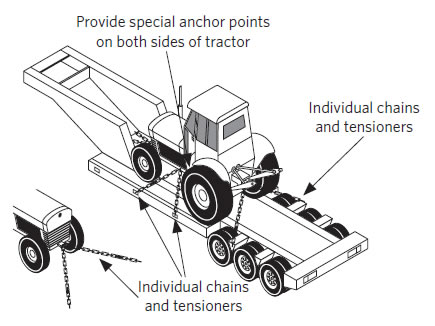
Figure 43 Suggested method of restraining a pneumatic tyred tractor
Hazard 1 – Height of the tractor.
Precaution: Check the route. Determine the minimum clearance available. If necessary, remove any component exceeding the height limit.
Hazard 2 – Forward or rearward movement of the tractor.
Precaution: Restrain with pairs of individual chains and tensioners at the front and rear of the tractor. The drawbar is an ideal rear anchor point. Where the front axle is unsuitable as an anchor point it is recommended that special anchor points be provided on the main frame.
Hazard 3 – Sideways movement of the tractor.
Precaution: Restrain with chains and tensioners on each side. Where necessary provide special anchor points on the tractor side frames to facilitate side restraint.
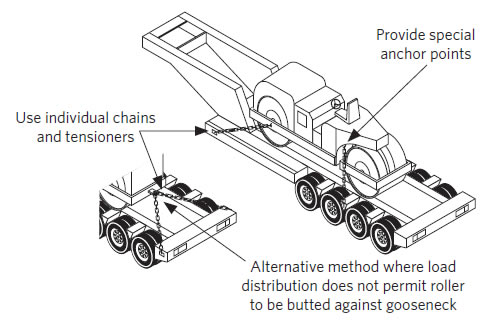
Figure 44 Suggested method of restraining a steel wheeled roller
Hazard 1 – Height of the roller.
Precaution: Check the route. Determine the minimum clearance available. Remove any components exceeding the limit.
Hazard 2 – Forward and rearward movement of the roller.
Precaution: Do not butt the front roll against the trailer gooseneck or restrain the front of the roller with chains attached to the front roll assembly as the front roll kingpin may be damaged. Where load distribution permits, butt the rear of the roller hard against the gooseneck and restrain with individual chains and tensioners to anchor points in the vicinity of the rear roll axle. Alternatively, locate the roller to meet the load distribution requirements and use the drawbar as the rear anchor point. To restrain the front of the machine provide special anchor points and fit individual chains and tensioners.
Hazard 3 – Sideways movement of the roller.
Precaution: This is restrained by chains used to control the forward and rearward movement.
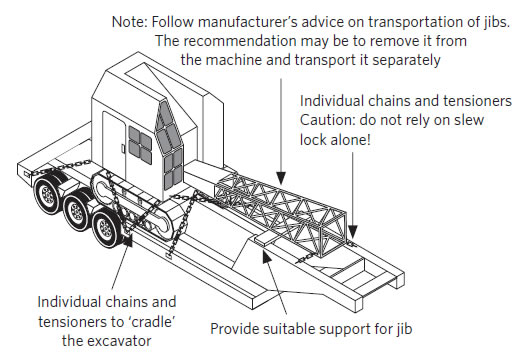
Figure 45 Suggested method of restraining a dragline
Hazard 1 – Height of the dragline.
Precaution: Check the route. Ensure the minimum clearance available exceeds the overall height of the dragline mounted on a low loader.
Hazard 2 – Width of the dragline.
Precaution: Check the overall width. Where the overall width exceeds the limit, a special permit should be obtained and any special conditions applicable rigidly applied.
Hazard 3 – Length of the dragline.
Precaution: Check the dragline manufacturer’s advice on transportation of the jib. If it is permissible to leave the jib or a section of it attached to the superstructure during transit, check that the extreme end of the jib does not, wherever possible, overhang the front or rear of the low loader (trailer) increasing the swept path of the combination.
Hazard 4 – Movement of the boom and superstructure relative to the chassis of machine.
Precaution: Engage a slew lock if fitted. If none are fitted, provide an independent restraint to prevent slewing motion.
Hazard 5 – Forward and rearward movement of the machine.
Precaution: Where load distribution permits, locate the dragline tracks against the gooseneck. ‘Cradle’ the machine in individual chains each tensioned with individual tensioners. The desirable maximum length of chains is 4 metres.
Hazard 6 – Sideways movement of the dragline.
Precaution: ‘Cradle’ chains provide restraint in this direction also.
Hazard 7 – Movement of buckets and attachments which are detached from the machine.
Precaution: Restrain with independent individual chain lengths. These should be no longer than are necessary to prevent forward, rearward and sideways movement.
Note: Follow the manufacturer’s advice on transportation of jibs. The recommendation may be to remove it from the machine and transport it separately.
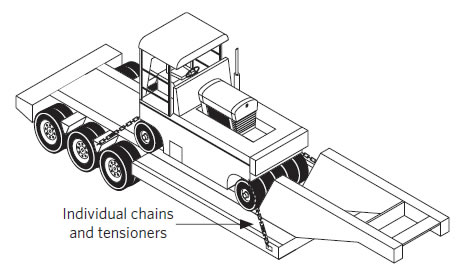
Figure 46 Suggested method of restraining a pneumatic tyred roller
Hazard 1 – Height of the roller.
Precaution: Check the route. Ensure the minimum clearance available does not exceed the limit. If necessary remove the canopy, exhaust pipe, air cleaner or any other component exceeding the limit.
Hazard 2 – Forward and rearward movement of the roller.
Precaution: Restrain with individual chains and tensioners positioned on four corners of the body.
Hazard 3 – Sideways movement of the roller.
Precaution: Restrained by chains used to control the forward and rearward movement.